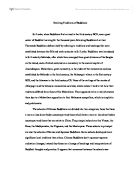Not an age of reason, but a revolt against rationalism. (Peter Gay) Discuss this characterisation of the Enlightenment.
Not an age of reason, but a revolt against rationalism. (Peter Gay) Discuss this characterisation of the Enlightenment. There is a carving by Giovanni Lapi that depicts Justice rejecting the death penalty1, this is a simple characterisation of the Enlightenment, taking one of its many aspects and displaying it in a plain form. The Enlightenment, which can, for argument's sake, be given the epoch of 1750-1800, is the movement that helped to change the outlook humans have on the world. Peter Gay asserts that the movement was spurned from the dissatisfaction contemporaries had with the previous period of intellectual thought: rationalism. The quest here is to discover what the Enlightenment was, and whether or not it was a movement bent on the rejection of rationalism. Benedictus Spinoza is a prime example of a rationalist, writing most of his works in the 1660s and 1670s. His book Ethics, Demonstrated in the Fashion of Geometry was so titled because he lay out his argument in the form of a mathematical proof, typical of the Rationalists. Rationalism was essentially an attempt to clarify the confusion that was brewing over the question of Christianity, and this was attempted via pure thought. The elimination of anything irrational and the use of knowledge as a source instead of sensationalism was paramount to the philosophising. Spinoza's predecessor, just like Spinoza himself
The Enlightenment was an intellectual movement in the Western world
The Enlightenment was an intellectual movement in the Western world during the 17th and 18th century; it was characterized as the age of reason. It was also composed of the scientific revolution, reason, nature, GOD, and man, which developed into a world perception that initiated radical improvements in art, politics, philosophy, theology and science. The sixteenth and seventeenth centuries in Europe were periods of important and dramatic changes in the way many people saw and understood the world. Not only did people begin to see the physical world as operating in a vastly different way from the way they had previously thought it operated, but also some European people were beginning to believe that the methods for discovering such new information could be applied in such a way that the new knowledge would be more powerfully accurate than knowledge had previously been. The first disciplines to be affected by these changes were mathematics and physics. Eventually, the Scientific Revolution and the Enlightenment also greatly influenced the understanding of political, economic, and social behavior. Several individuals played a significant role during the creation of the Enlightenment. Philosophers such as Thomas Hobbes, Baruch Spinoza, John Locke, and Immanuel Kant who believed that human rationale could not be used to fight the lack of knowledge, fallacy, and improve
Evolving Traditions of Buddhism.
Evolving Traditions of Buddhism Sri Lanka, when Buddhism first arrived in the third century BCE, was a great center of Buddhist learning for the thousand years following Buddhism's arrival. Therevada Buddhism defines itself by referring to traditions and teachings that were established between the fifth and tenth centuries in Sri Lanka. Buddhism was introduced to Sri Lanka by Mahinda, after which there emerged three great divisions of the Sangha on the island, each of which centered on a monastery in the ancient capital of Anuradhapura. Mahavihara, great monastery, is the oldest of the monasteries and was established by Mahinda in the third century, the Abhayagiri-vihara in the first century BCE, and the Jetavana in the third century CE. None of the writings of the monks of Abhayagiri and the Jetavana monasteries survived, which makes it hard to tell how their traditions differed from those of the Mahavihara. There appeared to be a rivalry between them due to a Mahavihara opposition to their Mahayana sympathies, which is simplistic and problematic. The schools of Chinese Buddhism are divided into two categories, those that have a more or less direct Indian counterpart and those which have a more or less direct Indian counterpart and those that are native to China. The principal schools are the Vinaya, the Kosa, the Madhyamaka, the Yogacara, and the Mantrayana. Those schools
What is Mary Shelley's relationship to the Enlightenment?
What is Mary Shelley's relationship to the Enlightenment? The Enlightenment broadly means the new wave of ideas and attitudes which surfaced during the late seventeenth an eighteenth centuries. They attempted to break free from old ideas and institutions such as the Catholic church. The Enlightenment had many facets, it was involved in science, philosophy, religion, politics, society, economics and nearly every other aspect of life. A number of philosophers during this time were interested in the notion of "the state of nature", this is a hypothetical situation of what human life was like before society was formed. It was argued that in the state of nature the human soul was fully exposed, this could help the present society to create a peaceful, harmonious and virtuous framework to live in. The conceptions of the state of nature varied greatly, from Hobbes' bloody war against all to Rousseau's belief in the noble savage - satisfied with the most basic requirements. Mary Shelley wrote Frankenstein, or, The Modern Prometheus in 1818. It is about a young scientist who manages to create a living monster. However, the monster is then left to its own devices and cast out of society. The monster becomes bitter and takes revenge on its creator. The book can be seen to have a number of interpretations, it was written towards the end of the Enlightenment period and so draws from this





